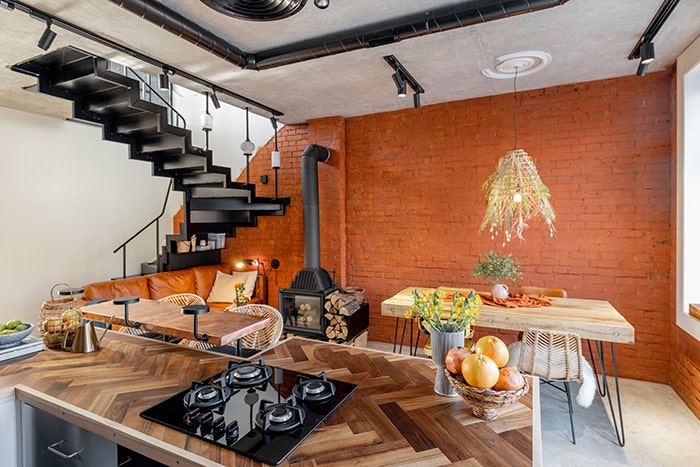How To Choose The Right Interior Design Accounting Software For Your Firm
At the heart of having an interior design business is turning spaces into beautiful, useful places to live. But success also depends on how well you handle your money. The next step is to pick interior design accounting software that will help you keep track of projects, bill clients, and make smart business decisions.

What Happens When You Don’t Have Good Accounting Tools
Let’s imagine: You just got an exciting new project. Your client loves your ideas and can’t wait to see their new space. But there’s a problem – you’re worried about keeping track of all the bills, payments, and expenses. Many designers try to manage their finances using basic tools like spreadsheets, leading to serious problems that can hurt their business.
Time becomes your enemy when using basic tools. Instead of focusing on design work, you spend precious weekends catching up on paperwork. Designers often find themselves searching through endless emails for old invoices, manually calculating markups, and chasing clients for payments. This administrative burden can steal 10-15 hours from your week – time that should be spent on creative work.
Money problems grow quickly without proper systems. Your profits suffer because:
- You miss tax write-offs
- Pay too much in taxes
- Can’t track project profitability
- Fall behind on bills
- Lose track of client deposits
The impact on client relationships can be even more damaging. Without proper software, you struggle to answer money questions quickly, send professional invoices on time, or keep payment schedules clear. This creates confusion and frustration for both you and your clients, potentially damaging your professional reputation.
How The Right Interior Design Accounting Software Makes Your Business Better
The right system transforms how you handle money in your business, giving you back control and peace of mind.
Time savings happen automatically. Instead of manual work, your software:
- Sends bills automatically
- Calculates all your markups
- Tracks payments for you
- Reminds clients when bills are due
- Creates reports with one click
Making more money becomes easier because you can see exactly how your business is performing. Good software shows you which projects bring in the most profit, helps you set the right prices, and makes sure you don’t miss any billable expenses. Many designers found they were undercharging for their services until they had clear data showing their true costs.
Understanding Design Business Needs
Interior design businesses face unique financial challenges that general business software often can’t handle. Your creative business operates differently from retail stores or standard service providers, requiring special tools that understand the complexity of design projects.
Project management in design is particularly complex. Unlike simple service businesses, you’re often juggling multiple projects that can run for months or even years. Each project has its own timeline, budget, and payment structure. Designers have reported that trying to track all these moving parts without specialized interior design accounting software often leads to missed deadlines and forgotten details.
Selecting and Integrating Your Software Solutions.
Choosing the right interior design accounting software combination can transform how your design firm operates. Let’s look at how different tools work together to support your business.
QuickBooks Online
QuickBooks has become a favorite among designers because it balances power with ease of use. It handles all the basic money tracking while connecting smoothly with design-specific tools. Most designers find they can learn the basics in just a few days, then gradually add more advanced features as they grow.
The pricing structure grows with your business:
- Basic ($30/month): Perfect for solo designers just starting out
- Plus ($85/month): Ideal when you’re ready to hire help
- Advanced ($200/month): Best for established firms managing multiple projects
Studio Designer
Studio Designer takes a different approach by focusing specifically on interior designers’ needs. This interior design accounting software understands how designers work because it was built just for our industry. It handles the unique aspects of design projects that general accounting software might miss, like tracking product orders, managing client presentations, and handling complex purchase orders.
Consider Studio Designer when your firm:
- Manages multiple large projects
- Needs detailed product tracking
- Wants to create professional presentations
- Has complex purchase order needs
- Values industry-specific features
Houzz Pro
Houzz Pro is a popular all-in-one platform designed specifically for interior designers. It combines project management, client collaboration, and robust accounting features into a single solution. Many designers appreciate how it streamlines their workflows and helps them deliver a high-quality client experience.
Key features of Houzz Pro include:
- Integrated project boards and timelines
- Client presentation and communication tools
- Product ordering and inventory tracking
- Advanced invoicing and payment processing
- Detailed financial reporting and analytics
Consider Houzz Pro when your firm:
- Needs an all-in-one design business platform
- Wants to improve client collaboration and communication
- Requires specialized product and inventory management
- Values comprehensive financial management features
Additional Tools and Integration
Creating a smooth-running design business often requires combining several specialized tools. Think of it like designing a room – each piece serves a specific purpose while working together to create a complete solution.
- Core Design Management
Mydoma Studio serves as your digital design headquarters. It transforms how you handle the creative side of your business. Designers find it particularly valuable for managing client communications and project files. Instead of digging through endless email chains and folders, everything stays organized in one place. Most designers report saving several hours each week just on file management and client updates.
- Project Coordination
Buildertrend works alongside your accounting software to keep projects running smoothly. It helps prevent costly mistakes by tracking every detail of your installations and renovations. Many designers say this tool pays for itself by preventing even one missed deadline or scheduling conflict. You’ll especially appreciate how it:
- Keeps installation schedules clear
- Coordinates with contractors
- Tracks project timelines
- Manages budgets
- Streamlines team communication
- Team and Payroll Management
Gusto solves one of the biggest headaches for growing design firms. Instead of spending hours figuring out payments and tax forms, Gusto handles everything automatically. Designers who switch to Gusto typically save 4-5 hours each pay period. The system:
- Processes payroll accurately
- Manages employee benefits
- Records time automatically
- Handles tax documents
- Keeps you compliant
Getting Started With Your New Software
Getting started with new interior design accounting software needs careful planning. Let’s break down each phase to ensure success.
Planning Phase (2-3 Weeks)
Getting Ready:
- Make a complete list of active projects
- Gather all financial records from the past year
- Note which tasks take the most time now
- List all vendors and their payment terms
- Document your current pricing structure
- Talk to your team about changes
Setting Goals:
- Identify biggest pain points to fix
- Set clear success measures
- Create realistic timelines
- Plan team training sessions
- Budget for setup costs
Setup Process (4-6 Weeks)
Week 1-2: Basic Setup
- Set up company information
- Connect bank accounts
- Add team members and permissions
- Create chart of accounts
- Set up tax rates
- Import client list
Week 3-4: Project Setup
- Create project templates
- Set up billing structures
- Import vendor lists
- Create invoice templates
- Set up markup calculations
- Configure payment terms
Week 5-6: Advanced Setup
- Set up automated reminders
- Create report templates
- Configure integration with design software
- Set up backup systems
- Create security protocols
- Test all systems
Training and Transition (4-8 Weeks)
Team Training:
- Basic software navigation
- Daily task procedures
- Project management tools
- Financial tracking methods
- Report generation
- Troubleshooting basics
Testing Phase:
- Run old and new systems together
- Test with one small project
- Practice common scenarios
- Document problems and solutions
- Adjust procedures as needed
Fine-Tuning (Ongoing)
Monthly Reviews:
Check all automations
- Review team feedback
- Adjust workflows
- Update templates
- Monitor efficiency gains
Success Tips:
- Start with basic features
- Add complexity gradually
- Document everything
- Keep team involved
- Celebrate small wins
Common Problems and Easy Fixes
- Problem: “I’m scared to switch software.”
Fix: Start with one small project first. Keep your old system running while you learn the new one.
- Problem: “There’s so much to learn!”
Fix: Learn one new thing each week. Start with what you use most, like invoices and expenses.
- Problem: “I don’t have time for this.”
Fix: Pick a quiet month to start. Maybe summer or winter when things are slower.

Daily Operations And Best Practices
Running a successful design firm requires a solid daily routine. By following a structured approach, you’ll stay on top of both creative and financial tasks while avoiding common pitfalls that can hurt your profits.
Start your day with financial clarity. The first hour of your morning sets the tone for everything that follows. Rather than jumping straight into design work, take 30 minutes to review your financial dashboard. This morning money routine has helped many designers catch potential problems before they become serious issues.
Morning Routine (9am-11am)
First Priority Tasks:
- Review overnight bank transactions
- Check for client payments
- Flag urgent vendor bills
- Update project statuses
- Check team schedules
Money Management:
- Process new expenses
- Send due invoices
- Update project budgets
- Check cash flow
- Schedule vendor payments
Project Management (11am-3pm)
Active Projects:
- Update project timelines
- Process change orders
- Track design hours
- Monitor budgets
- Update client portals
Product Management:
- Place new orders
- Track shipments
- Update receiving status
- Process returns if needed
- Update product catalogs
Financial Tasks (3pm-5pm)
End-of-Day Wrap Up:
- Review all transactions
- Process final invoices
- Check payment reminders
- Update time sheets
- Back up daily data
Weekly Tasks:
Monday:
- Review all project budgets
- Schedule team meetings
- Plan weekly cash needs
- Check upcoming deadlines
Wednesday:
- Process vendor bills
- Send client statements
- Update project reports
- Check inventory orders
Friday:
- Review weekly progress
- Plan next week’s tasks
- Send status updates
- Back up weekly data
Team Coordination
Daily Communication:
- Share project updates
- Assign new tasks
- Track time entries
- Monitor workloads
- Address questions
Using Reports To Boost Profitability
Understanding your reports makes the difference between a good design firm and a great one. Your software creates powerful reports that tell the story of your business’s health.
Daily Financial Snapshot
Start each day knowing exactly where your business stands. Your morning report should give you a quick but complete picture of your firm’s finances. Successful designers spend 15 minutes reviewing these numbers before starting their creative work.
Critical Numbers to Check:
- Think of these like your business’s vital signs:
- Available cash balance
- Pending client payments
- Due vendor bills
- Project budget status
- Team hour tracking
Project Profitability Tracking
Understanding which projects make money changes how you run your design firm. Many designers are surprised to learn their biggest projects aren’t always their most profitable. Your software helps tell the real story behind each project’s numbers.
- Time vs. Money Analysis
Look closely at how time relates to profit. One designer discovered she was losing money on small projects because she underestimated the time needed for client communications. Review each project’s:
- Design hours spent
- Team time allocation
- Client meeting time
- Administrative tasks
- Travel and site visits
- Product Management Impact
The way you handle products can make or break your project profits. Smart designers use their software to:
- Track every aspect of product ordering and delivery. This prevents costly mistakes and helps maintain healthy margins. Your system should show:
- Current markup rates
- Shipping costs
- Storage fees
- Damage claims
- Return processing time
Growing Your Design Business
Growing your firm requires smart planning and careful attention to your numbers. The right software helps you spot opportunities and avoid common growth mistakes.
Knowing When to Hire
Many designers struggle with hiring decisions. Your software provides clear signals about when to add team members. Consider this real example from a growing firm: “Our time tracking showed our senior designer was spending 60% of her time on admin tasks. Hiring an assistant freed her to take on five more projects, paying for the new hire in just two months.”
Look for these hiring indicators:
- Team overtime patterns
- Turned down projects
- Administrative overload
- Consistent profit margins
- Strong cash reserves
Adding New Services
Expanding your service offerings should be based on data, not just gut feeling. Your software helps you test and track new service lines.
Service Testing
Before fully launching a new service:
- Run a small pilot program
- Track all related costs
- Monitor time investment
- Measure client interest
- Calculate potential profits
Troubleshooting and Solutions
Even the best systems sometimes have problems. Understanding how to fix common issues keeps your business running smoothly.
Common Challenges
Project Management Issues:
- Problem: Going over budget
- Solution:
- Set up automatic budget alerts
- Track expenses in real time
- Review budgets weekly
- Document change orders immediately
- Hold regular budget reviews
Time Tracking Troubles:
- Problem: Missing or late time entries
- Solution:
- Use mobile apps for instant entry
- Set daily reminders
- Make it part of project closeout
- Review time sheets weekly
- Train team on proper coding
Billing Headaches:
- Problem: Delayed or incorrect invoices
- Solution:
- Create invoice templates
- Set up automatic billing
- Review before sending
- Track payment terms
- Follow up systematically
Money Management Fixes
Cash Flow Problems:
- Set up payment schedules
- Monitor aging reports
- Send automatic reminders
- Track vendor terms
- Keep cash reserves
Tax Troubles:
- Check tax settings monthly
- Track sales tax by state
- Document tax exemptions
- Keep good records
- Work with tax pros
Prevention Tips
Daily Habits That Help:
- Back up data daily
- Review transactions
- Update project status
- Check team entries
- Follow up on issues
Team Training:
- Regular software updates
- Share best practices
- Document procedures
- Have help resources ready
- Celebrate good habits
Contact us today for a free consultation on how our specialized accounting software can save you time, boost your profits, and help you grow. Choosing the right interior design accounting software is an investment that will pay off in saved time, increased profits, and the ability to focus on your true passion, design.
FAQs
What’s the best accounting software for a small interior design firm?
QuickBooks Online works well for most small firms, offering a balance of features and affordability.
How much should I budget for interior design accounting software?
Plan for $50-200 monthly, depending on features and firm size.
Can I use general accounting software for my design firm?
Yes, but you may need additional tools for design-specific features like product markup and purchase orders.
Do I need special training to use design accounting software?
Basic training is recommended for any system you choose. Most providers offer online tutorials and support.
How do I handle sales tax for both products and services?
Choose software that manages multiple tax rates and can separate product and service sales.
Can I access my accounting software from my phone?
Many programs offer mobile apps so you can check reports, send invoices, and record expenses on the go.
Share On:



